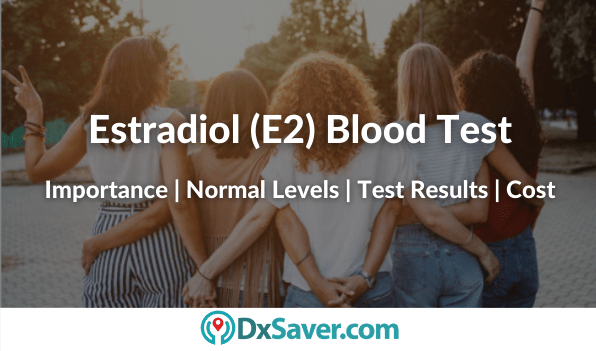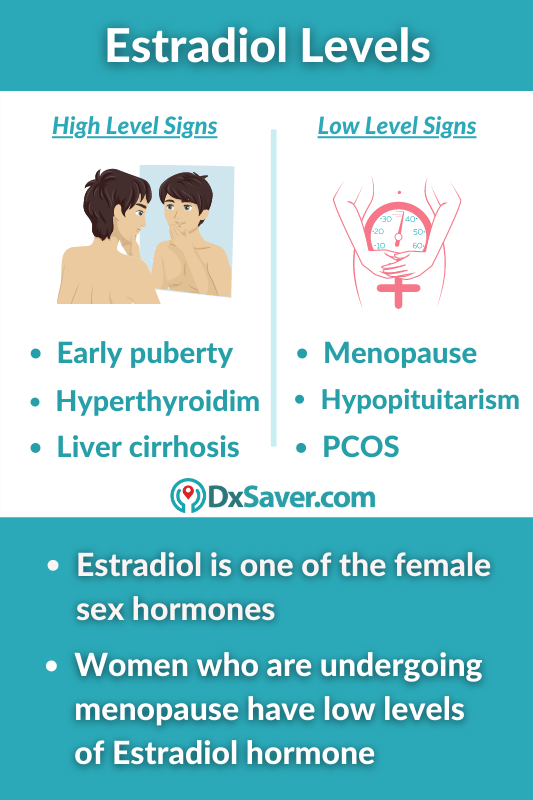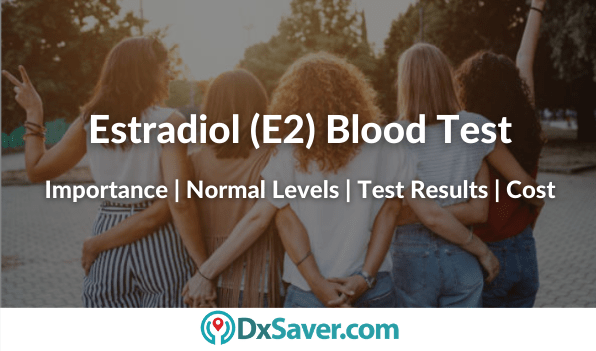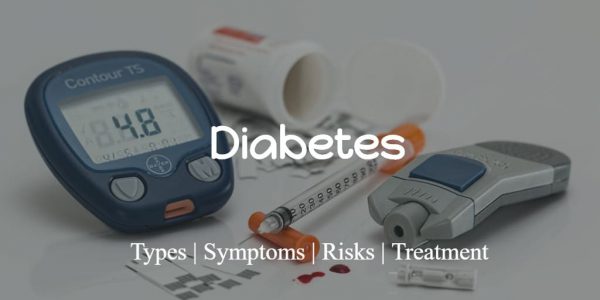
Estradiol is one of the three major components that make up the estrogen hormone. Estradiol is the most potent endogenous estrogen. E2 is a commonly knows term for estradiol, which is released from the ovaries and adrenal glands in nonpregnant females. This test is prescribed to measure estradiol levels in women. Men also secrete estradiol, where 75% of E2 is produced from testosterone and the rest of E2 is produced in the testes.
The article below covers all the relevant topics of the Estradiol test like the Estradiol test cost, who should get tested for an Estradiol test, normal Estradiol levels, symptoms of high Estradiol levels, test procedure, risks, and how to get tested for Estradiol levels.
- Estradiol test cost.
- What is Estradiol?
- Why is an Estradiol test done?
- Normal levels of Estradiol
- How is the Estradiol test performed?
- Is there any preparation required before the test?
- Are there any risks in the test?
- What does the test result mean?
- How to treat abnormal Estradiol levels?
- Providers Locations
For our readers who are more interested in knowing the Estradiol test cost beforehand, we would like to begin with that section.
How much does the Estradiol test cost?
Estradiol test cost ranges between $51 and $99 in different labs and facilities across the U.S. No prior appointment is required. Compare the price, order your test online and visit the nearest lab during lab business hours. Complete the procedure and get the results in your email in 2 to 3 business days. Doctor consultation is also available for further treatment or any kind of medical advice.
The following table shows the Estradiol test cost at 2 of our partner laboratories (CLIA – Certified) network located across the U.S.
Name of our Partner Labs | Book Online |
HealthLabs
| Offer Price$99 |
Personal Testing Lab
| Offer Price$51 |
Estradiol test cost with insurance
Most of the health insurance policies in the U.S. cover the cost of hormone tests that include the Estradiol test. However, the coverage offered by private health insurance companies and national health insurance programs like Medicare and Medicaid varies widely. So we recommend you to check the coverage of your health insurance plan with the insurance company before getting tested for Estradiol levels.
Our Estradiol testing providers do not accept any kind of health insurance plan. But, they can provide you with an itemized receipt containing all the details like the test name and code, and CPT code which is necessary for insurance reimbursement purposes.
What is an Estradiol test?
An Estradiol blood test is done to check the level of Estradiol hormone in the blood. Estradiol is one of the female sex hormones (one of the 3 E’s that makes Estrogen). This hormone plays an important role in puberty and fertility in females. Estradiol test helps to find out the causes of early or delayed puberty in girls, menopause in women, and other fertility-related complications. In boys to monitor the treatments for infertility.
What is Estradiol?
Similar to Testosterone which plays a predominant role in puberty, and masculinity in men, women produce a hormone called Estradiol (E2). Estradiol is a type of Estrogen that secrete in premenopausal females. It is produced from the aromatization of androgens and conversion from estrone in the ovary.
In women who are undergoing menopause, the ovary slows down the estrogen secretion and thus reducing the levels of Estradiol. Women who are in their postmenopausal produce little to (less than 20 pg/mL) Estradiol.
Gauging your Estradiol levels is crucial to analyze the cause of infertility, puberty evaluation in girls and postmenopausal women.
Importance of Estradiol
Estradiol is also frequently interchanged as 17 beta-estradiol. The ovaries, breasts, and adrenal glands in women are the core manufacturer of this hormone. If you are a pregnant woman the placenta also makes estradiol. Following are the prime roles played by Estradiol – helping the growth and development of female sex organs including –
- Breast development
- Growth of the uterus, vagina, and fallopian tubes
Estradiol also helps to control the way fat is distributed in the female body. Estradiol is also essential for the formation of bone and joint in females.
As our human anatomy share similar characteristics between sexes, men also have estradiol in their bodies but the levels are very low in general. In males, the adrenal glands and testes make estradiol.
Why is an Estradiol test done?
Your doctor may order an Estradiol test if your sex characteristics aren’t developing at a normal rate, for example, late puberty. In some cases, girls become mature at an early age than others, this is due to a high estradiol level than normal indicates. This is a condition known as precocious puberty in women.
Lower levels of estradiol can be an indication of late puberty. Estradiol test can help assess if there are problems with your adrenal glands.
Following issues can be addressed with help of Estradiol levels –
- Infertility in women
- Abnormal menstrual periods
- Abnormal bleeding between periods
It also helps in the treatment of hypopituitarism, or the underactive pituitary gland.
The estradiol test can help in gauging your ovary’s health and detect an ovarian tumor. The symptoms of ovarian tumor include:
- Bloating/swelling in your abdomen
- Feeling full after eating a small amount of food
- Lower abdominal pain
- Weight loss
- Frequent urination

Estradiol Test for Menopause
Estradiol test is more commonly ordered by your physician to test if your menstrual cycle has stopped and whether you are having symptoms of menopause. This test of your estradiol level can help your doctor determine if you’re preparing to enter menopause or you’re already going through the transition.
Pregnancy and Estradiol Test
Estradiol test comes in handy if you’re pregnant or you’re on infertility treatments, your doctor may order an estradiol test to help keep track of your progress. However, your estradiol performance alone cannot be used for diagnosis, it needs additional tests to help your doctor decide if further testing is necessary.
Normal levels of Estradiol
Estradiol levels need to normal, too much or too little can be a problem. They can cause health complications like weak bones, urinary tract infections, and even depression.
Normal levels of estradiol for menstruating women range from 15 to 350 picograms per milliliter (pg/mL). For postmenopausal, as the ovaries have stopped secreting the hormone, normal levels should be lower than 10 pg/mL.
For young boys and adults males, normal E2 values, as per the stages of your age are as follows:
- Stage I – IV: normal values are either undetectable or within the range of 0 to 38 pg/mL
- Stage V: normal values have to be between 10 and 40 pg/mL
For young girls and adult women, normal estradiol levels, as per the age stages, are as follows:
- Stage I – III: normal values are either undetectable or within the range of 0 to 60 pg/mL
- Stage IV – V: detectable normal values have to be between 15 to 350 pg/mL
If your respective test levels are below or above the mentioned levels, then your Estradiol levels need to be checked.
How is the Estradiol test performed?
As the name suggests, the estradiol blood test is a simple blood test. During this test, a lab technician or a phlebotomist will cleanse the skin with an antiseptic and place an elastic band around the upper arm so that the vein becomes visible and swells with blood. He/she then injects a needle and draws a sample of blood in a test tube. After the blood is drawn, he covers the injected area with a band-aid to stop bleeding. The typical blood specimen is then sent to the lab for analysis.
It takes less than 10 minutes to perform this test.
Is there any preparation required before the test?
You can continue with a regular diet and physical activates, they do not have a major influence on your test results. However, if you are taking certain drugs for medicinal purposes or on your own, then it is better to consult your physician – following are some that can affect your estradiol levels include:
- Birth control pills
- Estrogen therapy
- Glucocorticoids
- Phenothiazines
- The antibiotics tetracycline (Panmycin) and ampicillin
In the case of assessing your menstrual cycle, your physician may ask you to have your blood tested at a certain time of day or at a certain time in your cycle.
Following are some other health conditions that can manipulate your Estradiol levels –
- Anemia
- High blood pressure
- Kidney disease
- Reduced liver function
Are there any risks in the test?
There are no possible risks or complications as the estradiol test is a simple blood test. Sometimes you may feel dizziness, bruise, or redness in the injected area. But these symptoms will go away quickly. If you experience abnormal bleeding in the injected area, inform your physician immediately.
What does the test result mean?
For adult men, normal values are between 10 and 40 pg/mL. For adult women, levels are linked to their age and menopause.
High Estradiol Levels
If your estradiol levels are higher than normal, then it may indicate:
- Early puberty
- Tumors in the reproductive organs (ovaries or testes)
- Gynecomastia, which causes breasts in men
- Hyperthyroidism
- Liver cirrhosis
Low Estradiol Levels
If your estradiol levels are lower than normal then it may indicate:
- Menopause
- Turner syndrome, which is a genetic disorder in which a female has one X chromosome instead of two
- Ovarian failure where the ovaries stop functioning before the age of 40
- Polycystic ovarian syndrome (PCOS)
- Hypopituitarism
- Hypogonadism, where the reproductive organs (ovaries or testes) don’t produce enough hormone
How to treat abnormal Estradiol levels?
An estradiol test alone cannot diagnose a specific disease or detect the root cause. If the test results show low or high levels of estradiol, a doctor may recommend further tests to help pinpoint a diagnosis. Tests like follicle-stimulating hormone (FSH) which is another parameter for measuring fertility levels will be prescribed. In females, FSH is responsible for stimulating egg production, and in males, it triggers sperm production. Low levels of FSH may suggest problems with fertility.
Depending on the results and after identifying the underlying cause, any of the following will be prescribed:
- Changes to medication
- New medication
- Referral to a specialist
- Further testing and monitoring of estradiol levels
Providers Locations
Estradiol tests can be done at any of our partner’s 4500+ labs located across the US. To know the estradiol test cost, refer to the first section of the article.
Frequently Asked Questions
What is an estradiol blood test?
An estradiol blood test measures the level of estradiol, a form of estrogen, in the blood. Estradiol is a hormone that plays an important role in the growth and development of female sexual characteristics, as well as the regulation of the menstrual cycle.
Why is an estradiol blood test done?
An estradiol blood test is done to evaluate the level of estradiol in the body, which can be useful in the diagnosis and treatment of conditions such as infertility, menstrual irregularities, and menopause.
How is an estradiol blood test done?
An estradiol blood test is done by drawing a small amount of blood from a vein in your arm. The blood is then sent to a laboratory for analysis.
What do high levels of estradiol in the blood mean?
High levels of estradiol in the blood can be caused by conditions such as ovarian or adrenal tumors, and also by Hormone replacement therapy, birth control pills and pregnancy.
What do low levels of estradiol in the blood mean?
Low levels of estradiol in the blood can be caused by conditions such as hypogonadism, primary ovarian insufficiency, or menopause. If you have low levels of estradiol in your blood, you should contact your physician for further evaluation and treatment.
Other topics you may be interested in:-
- Anti-aging Testing Cost in the US
- What is Myoglobin and How it is Important for your Health?
- Normal Levels of CK Blood Hormone
- Importance of Troponin Hormone in Blood
- What are STDs that Cause Mouth Sores in Men and Women?
- What is RDW in the Blood Test?
- How much does Calcium Blood Test Cost in the US?
- Types of STDs that cause Skin Rash on Body and Genital
- Importance of BNP Levels in Blood
- Can You Get STD from Kissing?
- What is Metabolism and its Normal Levels?
- Fitness Testing Cost in the US
- Symptoms and Causes of Oral Herpes







